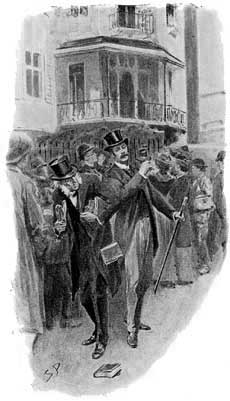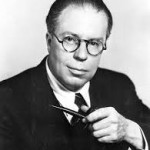A Scion Society of The Baker Street Irregulars

Data! Data! Data! – The Empty House
“‘Data! Data! Data!‘ he cried impatiently. ‘I can’t make bricks without clay.’”
– The Adventures of The Copper Beeches (COPP)

This column is composed of material (Data!) developed for a short course called Appreciating Sherlock Holmes that I teach twice a year in the Community Education Life Enrichment Program for a local community college. It is composed of “points of information” that are common to many / most / all of the 60 Canonical stories.
The information here has been researched by me or borrowed / stolen from many efforts of other Sherlockians.
HE HAS RETURNED . . . .
HERE GOES This month’s story is The Adventure of the Empty House
 CHRISTOPHER MORLEY SAID . . .
CHRISTOPHER MORLEY SAID . . .
“This story first appeared in The Strand Magazine in London, and Collier’s Weekly in New York, in October 1903. The American publication included the drawings by the most devoted of all Holmes’s illustrators, Mr. Frederic Dorr Steele. Those who were schoolboys in 1903 can well remember how we waited for the issues of Collier’s and families squabbled and cried “Dibbies on it first!”
DUMMIES SHORT SUMMARY (From Sherlock Holmes for Dummies by Steven Doyle & David Crowder)
“Holmes has been dead for three years when a lonely Watson becomes interested in the mysterious death of young Ronald Adair. But then this classic locked-room mystery becomes a shocking revelation: Sherlock Holmes lives!”
PUBLISHING HISTORY
• This is the 28th of the 60 tales published
• It was first published in The Strand Magazine in October 1903 and Collier’s Weekly on September 26, 1903
• It is part of The Return of Sherlock Holmes collection published in book form by George Newnes, Ltd., London, 1905 and McClure Phillip & Co., New York, 1905
• The British illustrator was Sidney Paget and the U.S. illustrator was Frederick Dorr Steele
HOW MANY WORDS?
According to C. E. Lauderback, 1960 – – found on SHERLOCKIAN.NET website of Chris Redmond
At 8,761 words EMPT has the 38th most words (#1 is VEIL – 4,499, #56 if NAVL – 12,701)
THE BEST OF SHERLOCK HOLMES (How do Sherlockians rate this story?)
• 1927 – Arthur Conan Doyle had it as #6 on list of 12 favorites
• 1944 – The Baker Street Irregulars voted it as #9 on their top 12 favorites
• 1954 – The Baker Street Irregulars voted it as #8 on their top 12 favorites
• 1999 – The Sherlock Holmes Society of London voted it 9th of the 56 short stories
CLASSIFYING THE CASE (From the Wandering Gipsies of Grimpen Mire of Decatur, Alabama)
This case is one of 23 classified as a MURDER and one of 14 where the perpetrator was either killed, arrested, or otherwise satisfactorily handled.
CHRONOLOGICALLY SPEAKING
Doyle was often very vague about stating WHEN the tale took place and included few contemporary references to help. Whether this was done intentionally or unthinkingly, the dating of events in the Canon is a very popular pastime pursued by several of our “scholars” researching and justifying their results to no end. We will again default to William Baring-Gould’s dating of Thursday, April 5, 1894 which making it 32nd story in time. This means that Holmes was 40 and Watson 42.
WHAT ELSE HAPPENED IN YEAR – – 1894
It is always interesting to see what else in happening at the same time as the stories.
• Gladstone retires; Rosebery becomes prime minister.
• Tower Bridge opens.
• Big wheel erected at Earl’s Court.
• Turbinia, first steam-turbine ship launched.
• Merchant Shipping Act: Masters, mates, and engineers to hold Board of Trade certificates.
• Blackpool Tower opens, 518 ft high.
• Alfred Dreyfus found guilty of treason.
• President Carnot of France assassinated by Italian anarchist.
• Hawaii becomes a republic.
• Sicilian bread riots lead to martial law and suppression of Italian socialist societies.
• Italians defeat Dervishes at Kassala.
• Kurds massacre Armenians at Sassoun.
• Alexander III of Russia died; Nicholas II (last Romanov tsar) acceeds to the Throne.
• Rudyard Kipling’s Jungle Book.
• Debussy, L’Apres Midi d’un Faun.
• Anthony Hope, The Prisoner of Zenda.
• Oscar Wilde, A Woman of No Importance.
• Escalators introduced (U.S.).
• Halstead (U.S.) details his operation for breast cancer (mastectomy).
• Flagstaff (Lowell) Observatory erected.
• J.H. Northrop (U.S.A.) invents automatic loom.
• Louis Luminre invents the cinematograph.
HOLMES AND WATSON – PERSONAL INFO
Watson is in practice and living in Kensington with no mention of wife. Holmes presumed to have perished in the falls of Reichenbach 3 years previously. Then Holmes reveals himself. Turns out he was not killed as presumed, but had been traveling all over the world, to Florence, Lhasa in Tibet, Persia, Mecca, Khartoum, and finally Montpellier, in the south of France. Mycroft was in on it but Watson was not. The old quarters at 221B were preserved and the fire damage repaired.
DRAMATIS PERSONAE
• COLONEL SEBASTIAN MORAN, Moriarty’s lieutenant and “the most dangerous man in London.”
• RONALD ADAIR, murdered with an air gun by Moran
• VON HERDER, a blind German mechanic who designed and built the air gun.
• EDITH WOODLEY, previously engaged to Adair
• MR. MURRAY, played cards with Moran and Adair on the afternoon of Adair’s murder.
• SIR JOHN HARDY, same as Murray
• PARKER, a garroter and henchman of Moran who witnessed Holmes’ return to Baker St.
• GODFREY MILNER and LORD BALMORAL, lost £400 to Moran and Adair a few weeks before Adair’s murder.
• SIGERSON, an alias used by Holmes while he was presumed dead.
• MONSIEUR OSCAR MEUNIER, of Grenoble — fashioned the mannequin.
“QUOTABLE SHERLOCK”
• “It is no joke when a tall man has to take a foot off his stature for several hours on end.”
• “Well, then, about the chasm. I had no serious difficulty in getting out of it, for the very simple reason that I was never in it.”
• “I have some knowledge, however, of baritsu, or the Japanese system of wrestling, which has more than once been very useful to me.”
• “It was not a pleasant business, Watson. The fall roared beneath me. I am not a fanciful person, but I give you my word that I seemed to hear Moriarty’s voice screaming at me out of the abyss.”
• “I trust that age doth not wither nor custom stale my infinite variety.”
• “I think you want a little unofficial help. Three undetected murders in one year won’t do, Lestrade. But you handled the Molesey Mystery with less than your usual — that’s to say, you handled it fairly well.”
• “My collection of M’s is a fine one.”
• “There are some trees, Watson, which grow to a certain height and then suddenly develop some unsightly eccentricity. You will see it often in humans. I have a theory that the individual represents in his development the whole procession of his ancestors, and that such a sudden turn to good or evil stands for some strong influence which came into the line of his pedigree. The person becomes, as it were, the epitome of the history of his own family.”
• “My dear Watson, there we come into those realms of conjecture where the most logical mind may be at fault.”
HOLMES’ FEE
There is no mention of a fee. It is conjectured that he was paid through whatever arrangement he had with the Yard, because he did turn the murderer of Adair over to Lestrade.
SHERLOCK ON THE BIG SCREEN & THE LITTLE SCREEN
• 1921 – The Empty House by Eille Norwood. The National Film and Television Archive at the BFI has viewing copies of this film but it has not been released
• 1931 – Sherlock’s Fatal Error with Arthur Wontner which combined it with The Final Problem
• 1980 – Vasily Livanov in the Hunt For the Tiger episode in the Russian Sherlock Holmes and Dr Watson series
• 1986 – Jeremy Brett in The Empty House in the BBC/Granada Sherlock Holmes series
• 1999 – The Adventure of the Empty House episode in the Sherlock Holmes in the 22nd Century (Animated TV series)
SHERLOCK HOLMES IN DISGUISE
The Master of disguise used the deception of being disguised 14 times in 11 of the 60 stories. In The Adventure of the Empty House Holmes posed as an elderly bibliophile trying to sell Watson some books (see illustration at top of this post).
UNRECORDED CASES (That involved Holmes)
Watson would tease / torture his readers with “I know something you don’t.” Oh my, how Sherlockians love this category. I have in excess of over 150 examples in my collection. This story has no unrecorded cases but a lot of explanation of Holmes’ three years of travel.
FAINTING IN THE CANON (courtesy of Sherlockian Karen Murdock)
Fainting is extremely common in the Canon, appearing, in some form, in 37 of the 60 tales. In 21 cases someone actually faints. In 22 cases someone almost faints. And in 5 cases someone pretends to faint. In this month’s story we have Watson’s own words on himself – – “I rose to my feet, stared at him for some seconds in utter amazement, and then appears that I must have fainted for the first and last time in my life.”
HOLMES’S PUBLISHED & PROJECTED WORKS
Sherlockians love this topic and are regularly searching for these items. Holmes mentions published or projected works in 11 of the stories but none in this month’s story.
NEWSPAPERS (Real and Fictional)
Though included in only 20 tales some of our more obsessed Sherlockians love this one. Nothing for them to love in this tale.
ANNOTATED SHERLOCK
The 60 Sherlock Holmes stories used English as spoken in England from the 1880’s until the 1910’s. Some words are foreign to us today and need a “contemporary translation.” In this month’s story we have just one term needing “translation.”
“shikari” – Hindu word for a sportsman or hunter such as Colonel Moran.
WEAPONS (from A Compendium of Canonical Weaponry by Dettman and Bedford)
… “a means by which one contends against another” … utilized in 57 of the 60 tales (all but CREE, 3STU, & YELL) There are several general categories to classify “weapons” that include: firearms, human agents, cutlery, animals, blunt instruments, extortion, toxin, blackmail, and miscellaneous. In our story, which is short, you will find all of the following:
• Service Revolver – Dr. Watson’s and is mentioned in 13 cases. The butt end of which to club Col. Sebastian Moran into submission.
• Game Rifle – Which Col. Sebastian Moran used in hunting big game – other than Sherlock Holmes and Ronald Adair.
• Air-Gun – Disguised as a cane, made by the blind German mechanic Von Herder expressly for Professor Morarity; which Moran used to kill Ronald Adair and attempting to do the same with Holmes.
• Rocks – Which were tossed at Sherlock Holmes by Col. Sebastian Moran, after Holmes had succeeded in escaping Professor Moriarty’s clutches.
• Hands – Of Sherlock Holmes on Professor Moriarty (on whom he had applied his knowledge of Baritsu, which probably entailed other parts of his body, such a shoulders, hips, and/or feet)
• Hands – Of Professor Moriarty, with which he grabbed Holmes on the ledge above Reichenbach Falls.
• Hands – Of Col. Sebastian Moran, which he used to try to strangle Holmes.
• Fist – Of Mathews, which he used to knock out Holmes’ left canine at Charing Cross Station. Unfortunately, we are told no more of this incident.
ODD STUFF
Sherlockians often wax poetically (not me). I don’t remember where I found this or who authored it, but you will like it:
A Sonnet for The Empty House
By Doctor John H. Watson
My sad bereavement weighed heavy on me.
But I roused myself enough to go see
If by using Holmes’ methods I could dare
To help with the case of Ronald Adair.
I stood in the crowd outside Adair’s home
Looking up at the scene of dread and gloom.
An elderly man with a snarling sound
A slight bump sent books tumbling to the ground.
Later that evening Sherlock Holmes came back.
Took off his disguise, my vision went black.
I remember his eyes focused on me.
Alive and concerned as ever could be
That sight I will look on ever fondly,
Holmes came back and ended my misery.
 Frank Mentzel, aka Merridew of Abominable Memory, is the current Gasogene of the Six Napoleons of Baltimore and is busy getting ready for that group’s 70th anniversary this September. Registration for his four week Appreciating Sherlock Holmes classes for the Community Colleges of Baltimore County, MD for the Fall semester will open this summer.
Frank Mentzel, aka Merridew of Abominable Memory, is the current Gasogene of the Six Napoleons of Baltimore and is busy getting ready for that group’s 70th anniversary this September. Registration for his four week Appreciating Sherlock Holmes classes for the Community Colleges of Baltimore County, MD for the Fall semester will open this summer.

Sorry, comments are closed for this post.